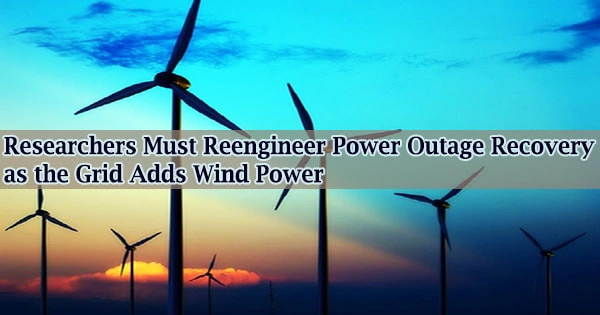There is a step-by-step recovery procedure known as a “blackstart” that has up until now relied on power from gas or hydro turbines churning away inside a power plant when the power grid goes down.
Everything was comparatively simple to manage. In order to reenergize a grid and survive short circuits and other problems, turn on the turbines, utilize them to spin generators, and monitor the steady, predictable flow of electrons.
But what if we’re talking about a wind power plant? A rural one that encompasses the entire region. one that is less consistent and reliable. one that is dependent on wind direction. What happens when a wind-dominant grid goes black?
How do engineers send electricity back to homes and businesses from a wind farm with hundreds of separate power turbines operating cooperatively?
According to a headline and study published in the journal Science in October 2019, there are three main “Grand challenges in the science of wind energy.” (Paul Veers of the National Renewable Energy Laboratory in Colorado is the lead author.)
When Hugo Villegas Pico, a Harpole-Pentair assistant professor of electrical and computer engineering at Iowa State University, saw that paper, he believed that he could develop solutions for grand challenge number three, which is the “optimization and control of fleets of wind plants comprising hundreds of individual generators working synergistically within the larger electric grid system.”
He and his research team received a three-year, $729,349 grant from the U.S. Department of Energy’s Office of Basic Energy Sciences in 2020 to work out how to coordinate the restoration of wind-dominated electric grids during a blackout.
Our contributions are significant to satisfy restoration, reliability, and interoperability standards. They are also important to not: jeopardize restoration processes, cause economical losses, and endanger lives, for example, if electricity is critical for heating in cold weather.
Villegas Pico and Vahan Gevorgian, a chief engineer at the National Renewable Energy Laboratory, describe the creation of grid-forming controllers and a stall-prevention subsystem that allow some wind turbines to blackstart a power grid in a study accepted for publication in IEEE Transactions on Energy Conversion and recently made available online.
It’s a critical step for building up the resilience of wind farms to blackouts.
“If wind power plants are not able to restore a power system, the incorporation of wind resources into electric grids could be limited by blackstart capability,” the researchers wrote in their paper.
With 11,660 installed megawatts and 437 more being built, Iowa generates 55 percent of its electricity from wind energy. As a result, wind power stations are now a common sight throughout the state.
So, what would it take to use them to restart a grid after a blackout?
Villegas Pico claims that creating a grid-forming control strategy that enables turbines to operate on the grid independently of any gas or hydro turbines, which is currently not possible, was the first challenge for “Type 4” turbines, which feature fully rated electronics converters to transfer all of their generating capacity to the grid.
“The control strategy is a software algorithm,” Villegas Pico said. “It steers the operation of wind turbines so they’re capable of reliably restoring power systems.”
For example, when a tree falls and short-circuits a portion of the transmission and distribution system, the software helps the turbines cooperate and endure the fault.
Designing an active protection mechanism to prevent wind turbines from stalling out and stopping during the recovery from a blackout presented the second issue.
The researchers have demonstrated through in-depth simulations that by incorporating their theories into a computer model, their novel control methods can reenergize a wind-dominated power grid, travel through asymmetrical faults, and withstand low-speed winds.
Villegas Pico claimed that using wind power to rebuild electricity systems could speed up the process in areas like Iowa where there are an increasing number of wind farms. Simply put, there are several turbines available today.
According to Villegas Pico, the research team is also utilizing these advancements in battery-powered power systems and other types of wind turbines. As part of the initiative, tools for artificial intelligence and weather forecasting are being created to aid operators in planning the restoration of wind-dominated grids.
According to Villegas Pico, it might only take a few years before the new developments are applied to wind power facilities and help utilities and their clients.
“Our contributions are significant to satisfy restoration, reliability, and interoperability standards,” the researchers wrote. “They are also important to not: jeopardize restoration processes, cause economical losses, and endanger lives, for example, if electricity is critical for heating in cold weather.”





